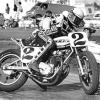I thnik Moto Gp bikes are cool, simple yet very subtle in many ways. I've just been reading the KTM website claiming 270 bhp for their bike. The minimum weight for Moto Gp is 157kg excluding rider versus 702 kg with driver for F1 in 2016.
So with a , say, 63kg rider, the bike is 220kg versus 702kg for the car. At 270 bhp the car needs 860 bhp for an equal power to weight ratio. Now that is about where a F1 car sits in terms of power but surely the bikes very small frontal area, lack of wings and semi-enclosed front tire gives it less drag?
So my guess is that from just above traction limited speed , maybe 90 mph, to typical end of straight the Moto Gp bike would out-drag the F1 car. Am I right please?
I dont think th discusion is purely technical because teh way a car accelerates , with the noise, is a key part of the appeal of racing and not just corner speed.
Edited by mariner, 09 December 2016 - 16:47.


















